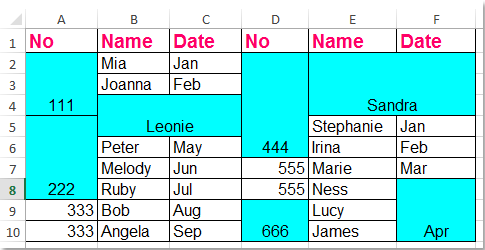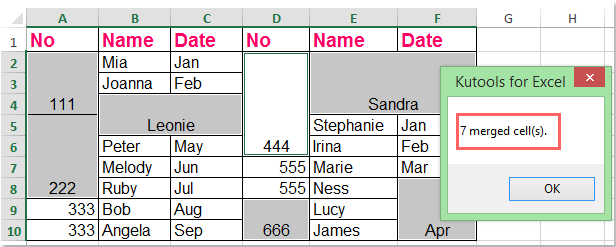엑셀에서 모든 병합된 셀을 식별하고 선택하는 방법은 무엇인가요?
엑셀에서 모든 병합된 셀을 찾아 선택하는 방법을 알고 있나요? 여기 엑셀에서 선택 영역이나 범위 내의 모든 병합된 셀을 빠르게 식별하고 선택할 수 있는 세 가지 멋진 방법이 있습니다.

찾기 명령어로 모든 병합된 셀 식별 및 선택하기
다음 단계에 따라 찾기 명령어를 사용하여 활성 워크시트의 모든 병합된 셀을 식별하고 선택할 수 있습니다:
1. 홈 > 찾기 및 선택 > 찾기를 클릭하여 찾기 및 바꾸기 대화 상자를 엽니다. Ctrl + F 키를 눌러도 찾기 및 바꾸기 대화 상자를 열 수 있습니다.
2. 대화 상자에서 서식 버튼을 클릭합니다. (서식 버튼을 찾을 수 없다면 옵션 버튼을 클릭하여 대화 상자를 확장하세요.) 스크린샷 보기:

3. 나타난 찾기 서식 대화 상자에서 정렬 탭 아래의 텍스트 제어 섹션에서 병합된 셀 옵션만 체크하고 확인을 클릭합니다.

4. 이제 다시 찾기 및 바꾸기 대화 상자로 돌아가 모두 찾기 버튼을 클릭합니다. 모든 병합된 셀은 이 대화 상자의 하단에 나열됩니다. Shift 키를 누른 상태에서 모든 검색 결과를 선택합니다.
활성 시트의 모든 병합된 셀은 모든 검색 결과를 선택하면 선택됩니다. 스크린샷 보기:

팁: 특정 선택 영역에서만 병합된 셀을 식별, 찾고 선택하려면 먼저 범위를 선택해야 합니다.
Kutools for Excel로 모든 병합된 셀 선택 및 개수 세기
Kutools for Excel의 병합된 셀 선택 도구는 한 번의 클릭으로 선택 영역 내의 모든 병합된 셀을 식별, 찾고 선택하는 데 도움을 줍니다.
Kutools for Excel 설치 후 다음 단계를 수행하세요:( 지금 바로 Kutools for Excel 무료 다운로드! )
1. 병합된 셀을 선택하려는 데이터 범위를 선택합니다.
2. Kutools > 선택 > 병합된 셀 선택을 클릭합니다. 스크린샷 보기:

3. 선택 영역의 모든 병합된 셀이 즉시 선택되며, 병합된 셀의 개수도 함께 계산됩니다. 스크린샷 보기:
VBA 코드로 모든 병합된 셀 식별하기
VBA 1: 모든 병합된 셀 식별 및 강조 표시하기
1. ALT + F11 키를 누르면 Microsoft Visual Basic for Applications 창이 열립니다.
2. 삽입 > 모듈을 클릭하고 모듈 창에 다음 매크로를 붙여넣습니다.
Sub FindMergedcells()
'updateby Extendoffice
Dim x As Range
For Each x In ActiveSheet.UsedRange
If x.MergeCells Then
x.Interior.ColorIndex = 8
End If
Next
End Sub
3. F5 키를 눌러 이 매크로를 실행합니다. 활성 워크시트의 모든 병합된 셀이 식별되고 강조 표시됩니다. 스크린샷 보기:

VBA 2: 모든 병합된 셀 식별 및 목록 만들기
1. ALT + F11 키를 누르면 Microsoft Visual Basic for Applications 창이 열립니다.
2. 삽입 > 모듈을 클릭하고 모듈 창에 다음 매크로를 붙여넣습니다.
Sub ListMergedcells()
'updateby Extendoffice
Dim x As Range
Dim sMsg As String
sMsg = ""
For Each x In ActiveSheet.UsedRange
If x.MergeCells Then
If sMsg = "" Then
sMsg = "Merged cells:" & vbCr
End If
sMsg = sMsg & Replace(x.Address, "$", "") & vbCr
End If
Next
If sMsg = "" Then
sMsg = "No merged cells."
End If
MsgBox sMsg
End Sub
3. F5 키를 눌러 이 매크로를 실행하면 모든 병합된 셀이 팝업 대화 상자에 나열됩니다. 스크린샷 보기:

관련 기사
엑셀에서 보호된 워크시트 내에서 셀 병합을 허용하는 방법은 무엇인가요?
기본적으로 보호된 워크시트에서는 사용자가 셀을 병합할 수 없습니다. 그러나 본 문서에서 제공하는 VBA 방법을 통해 보호된 워크시트에서도 셀을 병합할 수 있습니다.
엑셀에서 표 형식으로 지정된 범위의 셀을 병합하는 방법은 무엇인가요?
엑셀에서는 아래 스크린샷과 같이 연속된 여러 셀을 하나로 쉽게 병합할 수 있는 병합 및 가운데 맞춤 기능을 사용할 수 있습니다. 하지만 엑셀에서 표 형식으로 지정된 범위의 셀은 병합할 수 없는데, 이를 처리할 수 있는 방법이 있을까요?
엑셀에서 내용을 가운데 맞추지 않고 셀을 병합하는 방법은 무엇인가요?
엑셀에서 두 개 이상의 셀을 병합할 때 병합 및 가운데 맞춤 기능이 유용합니다. 하지만 때때로 아래 스크린샷과 같이 셀을 병합하지만 내용을 가운데 맞추지 않으려면 어떻게 해야 할까요? 이 튜토리얼에서는 엑셀에서 이 작업을 해결하는 방법을 소개합니다.
엑셀에서 셀을 분리하고 중복 값으로 채우는 방법은 무엇인가요?
많은 병합된 셀을 포함하는 워크시트가 있고, 이제 아래 스크린샷과 같이 병합된 셀에서 원래 값을 자동으로 아래로 채워 넣으면서 분리해야 한다고 가정해 봅시다. 이 작업을 어떻게 빠르게 처리할 수 있을까요?
최고의 오피스 생산성 도구
| 🤖 | Kutools AI 도우미: 데이터 분석에 혁신을 가져옵니다. 방법: 지능형 실행 | 코드 생성 | 사용자 정의 수식 생성 | 데이터 분석 및 차트 생성 | Kutools Functions 호출… |
| 인기 기능: 중복 찾기, 강조 또는 중복 표시 | 빈 행 삭제 | 데이터 손실 없이 열 또는 셀 병합 | 반올림(수식 없이) ... | |
| 슈퍼 LOOKUP: 다중 조건 VLOOKUP | 다중 값 VLOOKUP | 다중 시트 조회 | 퍼지 매치 .... | |
| 고급 드롭다운 목록: 드롭다운 목록 빠르게 생성 | 종속 드롭다운 목록 | 다중 선택 드롭다운 목록 .... | |
| 열 관리자: 지정한 수의 열 추가 | 열 이동 | 숨겨진 열의 표시 상태 전환 | 범위 및 열 비교 ... | |
| 추천 기능: 그리드 포커스 | 디자인 보기 | 향상된 수식 표시줄 | 통합 문서 & 시트 관리자 | 자동 텍스트 라이브러리 | 날짜 선택기 | 데이터 병합 | 셀 암호화/해독 | 목록으로 이메일 보내기 | 슈퍼 필터 | 특수 필터(굵게/이탤릭/취소선 필터 등) ... | |
| 15대 주요 도구 세트: 12 가지 텍스트 도구(텍스트 추가, 특정 문자 삭제, ...) | 50+ 종류의 차트(간트 차트, ...) | 40+ 실용적 수식(생일을 기반으로 나이 계산, ...) | 19 가지 삽입 도구(QR 코드 삽입, 경로에서 그림 삽입, ...) | 12 가지 변환 도구(단어로 변환하기, 통화 변환, ...) | 7 가지 병합 & 분할 도구(고급 행 병합, 셀 분할, ...) | ... 등 다양 |
Kutools for Excel과 함께 엑셀 능력을 한 단계 끌어 올리고, 이전에 없던 효율성을 경험하세요. Kutools for Excel은300개 이상의 고급 기능으로 생산성을 높이고 저장 시간을 단축합니다. 가장 필요한 기능을 바로 확인하려면 여기를 클릭하세요...
Office Tab은 Office에 탭 인터페이스를 제공하여 작업을 더욱 간편하게 만듭니다
- Word, Excel, PowerPoint에서 탭 편집 및 읽기를 활성화합니다.
- 새 창 대신 같은 창의 새로운 탭에서 여러 파일을 열고 생성할 수 있습니다.
- 생산성이50% 증가하며, 매일 수백 번의 마우스 클릭을 줄여줍니다!
모든 Kutools 추가 기능. 한 번에 설치
Kutools for Office 제품군은 Excel, Word, Outlook, PowerPoint용 추가 기능과 Office Tab Pro를 한 번에 제공하여 Office 앱을 활용하는 팀에 최적입니다.
- 올인원 제품군 — Excel, Word, Outlook, PowerPoint 추가 기능 + Office Tab Pro
- 설치 한 번, 라이선스 한 번 — 몇 분 만에 손쉽게 설정(MSI 지원)
- 함께 사용할 때 더욱 효율적 — Office 앱 간 생산성 향상
- 30일 모든 기능 사용 가능 — 회원가입/카드 불필요
- 최고의 가성비 — 개별 추가 기능 구매 대비 절약
